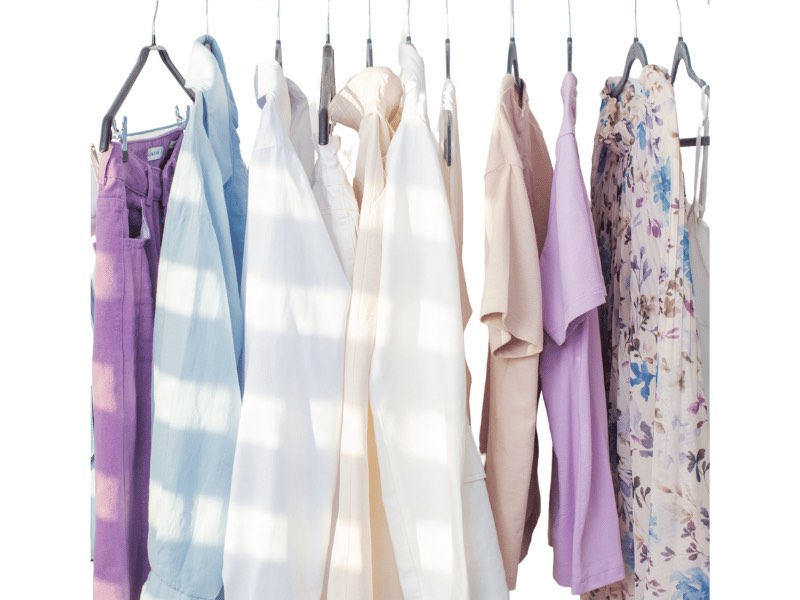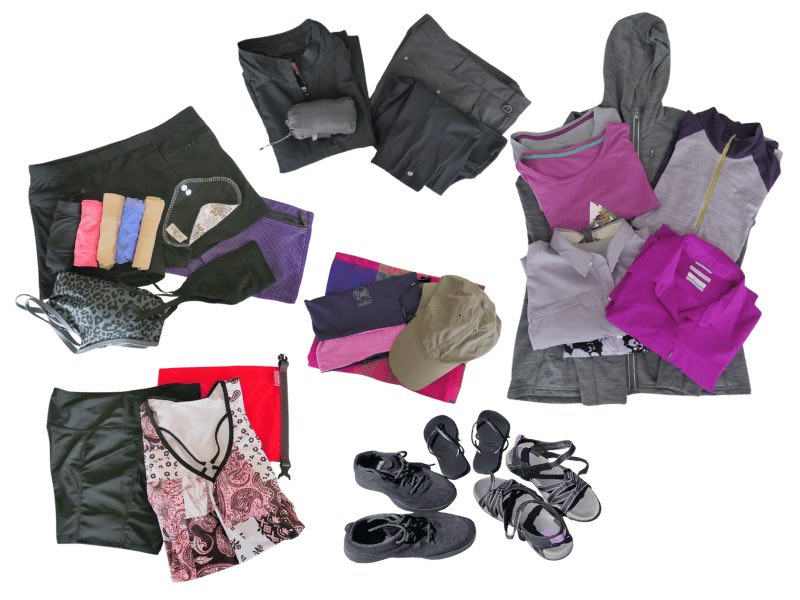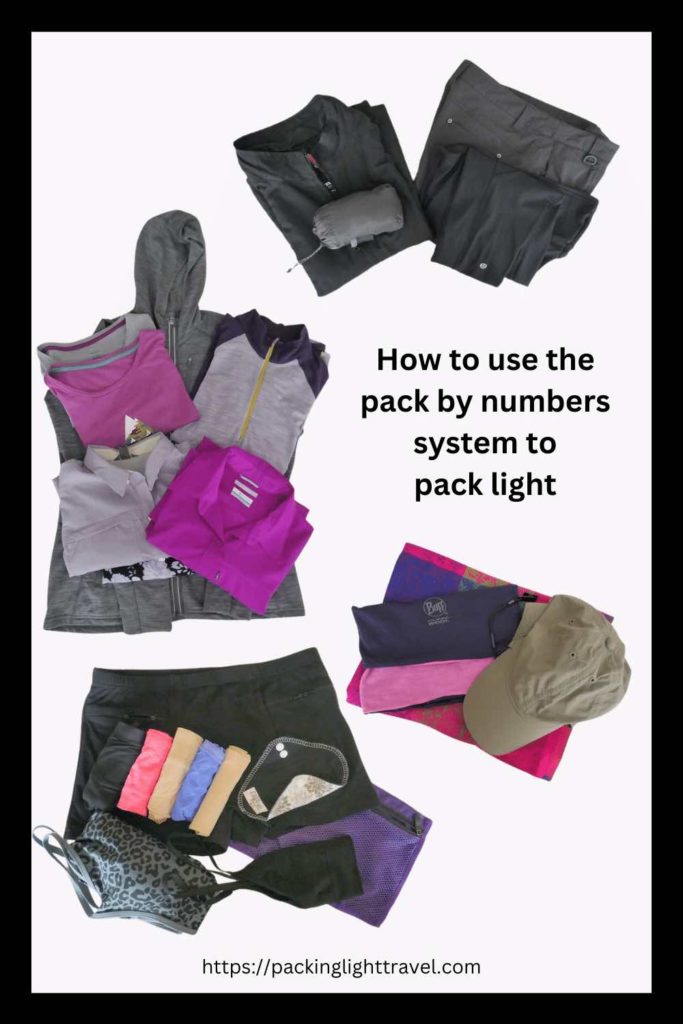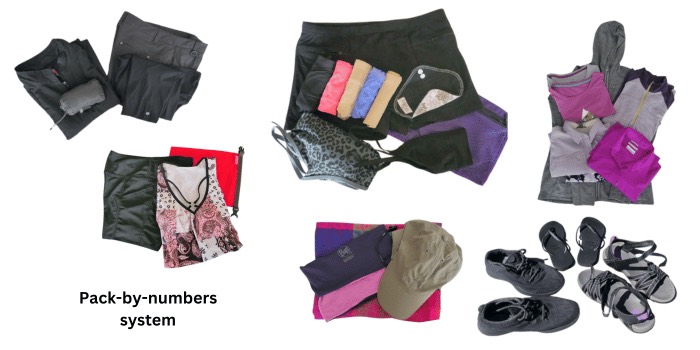If you’d like to find ways to limit the amount of clothing you pack, have you come across the pack-by-numbers system? It’s a strategy adopted by many travellers committed to one-bag or carry-on travel.
What is the pack-by-numbers system?
The pack-by-numbers system is a simple strategy to pack fewer clothes by limiting the number of pieces in each category. Categories could include tops, bottoms, underwear, socks, and shoes.
My numbers are 2, 3, 5, 5, 3, 2. Some people use the 5-4-3-2-1 packing method. There’s also the rule of 3 packing philosophy. Or the 3:1 approach works for some people. I’ve also encountered travellers who adopt the 1-2-3-4-5-6 rule of packing.
How does the pack-by-numbers system work?
There are many variations. Travellers choose which pack-by-numbers system works for them, given their travel style and type of trip they’re undertaking.
- There’s room for flexibility to add pieces outside the chosen system. These might include a swimsuit, jacket, vest, pyjamas, and a rain jacket.
- The system works best with a capsule wardrobe of complementary colours and designs where every piece of clothing goes with every other piece. It means less clothes but more outfits with interchangeable pieces. So if the number of tops and bottoms is five and three respectively, 15 different outfits or ‘looks’ become possible.
- Unless the trip involves a special event requiring a particular outfit, there’s no room for clothing that will be worn once or orphan pieces that don’t go with anything else.
- It’s also helpful if the pack-by-numbers system includes multipurpose pieces. Examples include a pashmina that can double as a swimsuit cover-up or a two-piece swimsuit where the shorts can be worn as shorts, underwear, or loungewear. Leggings can double as an extra layer of warmth.
- It also involves a plan on when and how to do laundry. Many devotees of the system choose clothing in lightweight, quick-drying fabrics that can dry overnight.
- Merino is a popular fabric because of its moisture-wicking and odour-resistant properties. It can be washed less often and dries quickly. The same merino socks can be worn several times between washes, so I only pack two pairs.
- The challenge is to remain committed to the system. After trying on each top with each bottom and eight tops are likely candidates, they need to be reduced to five tops if that is the chosen number.

5 Examples of the pack-by-numbers system
(i) 2, 3, 5, 5, 3, 2
My numbers, stacked somewhat vertically, are 2, 3, 5, 5, 3, 2. For most trips, it means 2 pairs of socks, 3 bottoms, 5 panties, 5 tops, 3 pieces of head/neck gear, and 2 bras.
Outside my numbers are two pairs of shoes that go with every outfit. In addition, a pair of Havaianas Slim flip flops double as shower shoes, slippers, and beach wear. Depending on the season and destination, I’ll add one or two pieces of outerwear, such as a travel vest, packable puffy jacket, and packable rain jacket. For warm destinations, I might add one swimsuit and one dress. One or two long-sleeved merino mid-layers, one with a hood, will reduce the five tops to four or three.

(ii) 1-2-3-4-5-6
Packing experts are REI, a US-based Co-op, describe the 1-2-3-4-5-6 pack-by-numbers system as:
- 1 hat
- 2 pairs of shoes
- 3 bottoms
- 4 tops
- 5 pairs of socks
- 6 pairs of underwear (plus one bra for women)
Beyond that, there’s flexibility to include swimwear, rainwear, or other specific items related to a trip. These experts also suggest packing up to seven days’ worth of clothing no matter how long the trip.
(iii) 3:1 ratio
Escape, an Australian travel brand advocates packing three tops for every bottom. The rationale is that pants and skirts take up more room than shirts, and bottoms don’t need to be washed after each wear.
(iv) Rule of 3
Freelance writer Gretchelle Quiambao suggests packing three of everything: three shirts, three bottoms, three dresses, three jackets, and three pairs of shoes. The key is to ensure all pieces can be combined to make several different outfits.

(v) 5, 4, 3, 2, 1
DIY fashion blogger Geneva Vanderzeil adapted the 5, 4, 3, 2, 1 system for a trip to Greece. With seven flights and three ferries within ten days, Geneva was committed to the packing-by-numbers system with carry-on luggage only:
- 5 tops
- 4 bottoms
- 3 dresses and 3 pairs of shoes
- 2 swimsuits and 2 bags
- 1 hat, 1 watch, and 1 pair of sunglasses.
Conclusion
An appealing feature of the pack-by-numbers system is that it’s not a rigid formula or guide. Travellers have the flexibility to choose the numbers that work for them. The underlying principle is to encourage travellers interested in lightening their load to be intentional about what and how much they pack. For additional insights, see Top 20 tips on how to pack light.
If you found this post helpful, please share it by selecting one or more social media buttons. Do you use the pack-by-numbers system? If so, what is your approach? Please share your thoughts on this topic in the comments. Thank you.
Care to pin it for later?







Thanks for sharing this. I use something similar, but never had a name for it. The only problem I run into is when I am taking one trip to 2 different climates. For example, I recently spent time in the UK and then went on a hiking trip in Tenerife in January.
Sonia recently posted…Epic Active Tenerife Itinerary
I agree. It’s a challenge. My next trip will experience -1 Celsius in northern Norway and +28 in India. Still, I think with a super warm packable puffy jacket and layers, it can be accomplished while remaining true to the pack-by-numbers system. Fingers crossed.
Anne, I’m curious how you ended up packing for this trip? I’m going on a trip to Italy, England and Norway soon and am struggling with how to pack for those extremes.
Hello Sue. The trip with those extremes is planned for August to November this year and I’m yet to pack. However, I’ve given it considerable thought. I plan to use my pack-by-numbers system as a guide (not as a strict formula) to ensure I stay within carry-on limits with luggage I can manage. I expect some of my numbers (2,3,5,5,3,2) will remain intact (2 socks, 5 panties, 2 bras) but I’ll adjust my tops, bottoms, and head/neck gear to remain comfortable given the extremes. As with all trips, layers will prevail. To my 3 bottoms, I expect to add a pair of merino long johns, and to my 3 head/neck gear I’ll include a long merino Buff and add a wool toque (and gloves that can accommodate rechargeable hand warmers). I’ll likely increase my tops to 6 with an extra merino layer for insulation. My outerwear (not included in my numbers) will include a very warm puffy jacket that packs into its pocket and a packable windproof, waterproof, breathable rain jacket that fits over the puffy jacket. The cooler temperatures are at the beginning of the trip (UK, Switzerland, Slovenia, Norway) and the warm weather is at the end of the trip (India) where I may purchase a couple of suitable pieces to complement what I pack, especially if my clothes prove inadequate for the weather and cultural norms. Hope this helps, and thank you for dropping by.
It might take a little time to get your wardrobe figured out and matching, but should be easy to pack once done.
Jolayne recently posted…25 Awesome Beachside Getaways Around the World
Very clever. I’ve never seen it done this way. Saving and gonna try it!